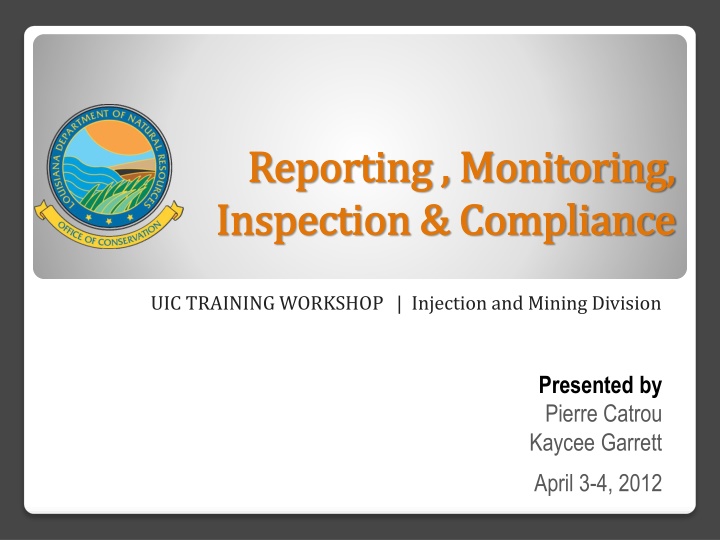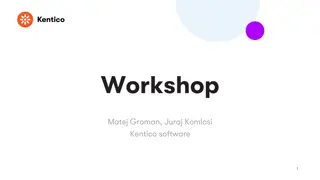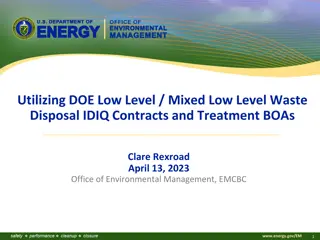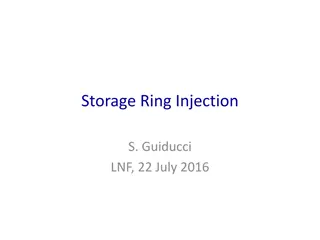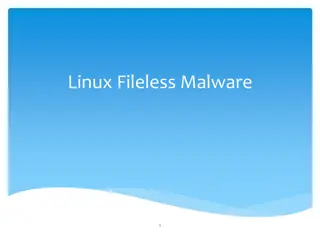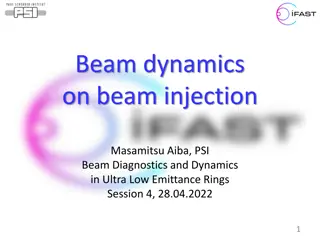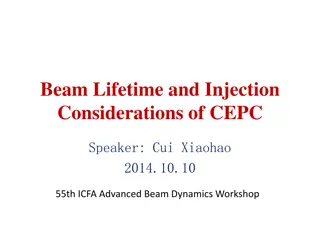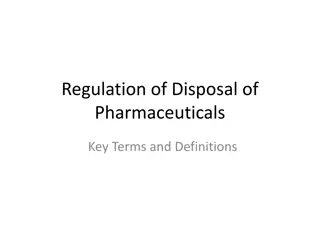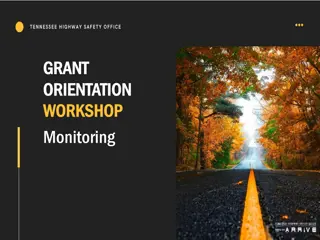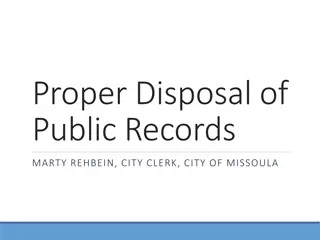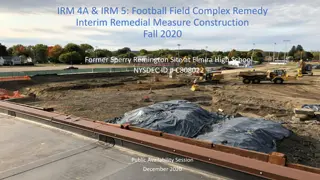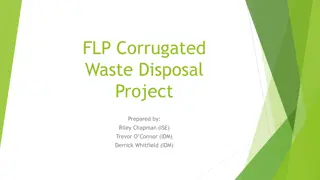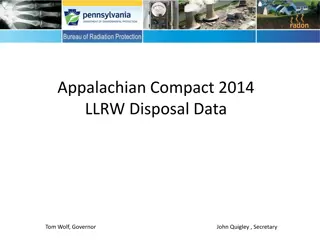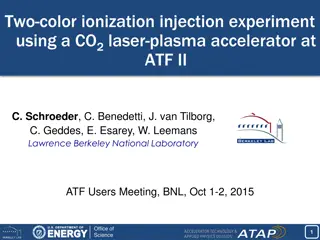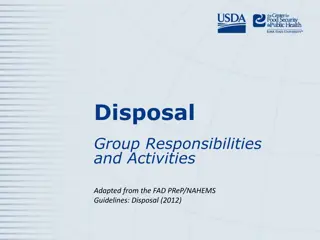Annual Disposal/Injection Well Monitoring Report Workshop Overview
Discover the key aspects of UIC Form UIC-10 and its instructions for reporting, monitoring, inspection, and compliance in the Injection and Mining Division. Learn about the annual submission requirements, community well information, and the Source Fluid Attachment process. Get insights into handling manifested and non-manifested fluids in Class II Disposal/Injection wells. Attendees will gain a comprehensive understanding of the reporting and monitoring procedures essential for maintaining operational compliance. Join Pierre Catrou and Kaycee Garrett in this informative workshop held on April 3-4, 2012.
Download Presentation

Please find below an Image/Link to download the presentation.
The content on the website is provided AS IS for your information and personal use only. It may not be sold, licensed, or shared on other websites without obtaining consent from the author.If you encounter any issues during the download, it is possible that the publisher has removed the file from their server.
You are allowed to download the files provided on this website for personal or commercial use, subject to the condition that they are used lawfully. All files are the property of their respective owners.
The content on the website is provided AS IS for your information and personal use only. It may not be sold, licensed, or shared on other websites without obtaining consent from the author.
E N D
Presentation Transcript
Reporting , Monitoring, Reporting , Monitoring, Inspection & Compliance Inspection & Compliance UIC TRAINING WORKSHOP | Injection and Mining Division Presented by Pierre Catrou Kaycee Garrett April 3-4, 2012
Reporting Reporting 2
Form UIC Form UIC- -10 Annual Disposal/ Injection Well Monitoring Report 10 Annual Submission Required for all Unplugged Injection Wells Forms are sent to operators in February of the year following the reporting year (ie: Sent out in February 2012 for the 2011 reporting year) Forms must be filled in and submitted to IMD by May 31st Plugged and Abandoned or Transferred Wells Download the Form UIC-10A when the P&A or transfer occurs Complete the form for the portion of the year that the well was operated www.dnr.louisiana.gov >> Conservation >> Forms/Reports/Documents >> Injection & Mining Division >> Form UIC-10A 3
Form UIC Form UIC- -10 Instructions 10 Instructions Form UIC-10 Organization Information Injection Pressure, Annulus Pressure, Injection Rate, and Volume Injected each month Well Information Community or Individual Well Community Saltwater Disposal Well/System Notification/Certification Replaces the need to file a FORM UIC-13 annually, after the initial FORM UIC-13 is on record 4
Instructions Continued Instructions Continued Source Fluid Attachment Must be completed for each Class II Disposal/Injection well and submitted with the Form UIC-10 or Form UIC-10A. All sources of fluid injected into these wells must be reported using this attachment sheet. Commercial SWD facilities are not required to complete the Source Fluid Attachment sheet of manifested fluids, however, this sheet must be completed for any non-manifested fluids such as fluids received by pipeline. 8
Instructions Continued Instructions Continued Source Fluid Attachment- Source Types Source Type A Produced fluids from oil and gas production wells operated by your organization located within the field in which the subject injection well is located Group all Source Type A Fluids LUW Code. Complete each column where A is marked in the header 9
Instructions Continued Instructions Continued Source Type B Produced fluids from oil and gas production wells operated by your organization located in fields other than the field in which the subject injection well is located Group all Source Type B Fluids by Serial Number Complete each column where B is marked in the header Source Type C Produced fluids from oil and gas production wells operated by organizations other than yours. Group all Source Type C Fluids by Serial Number Complete each column where C is marked in the header 10
Instructions Continued Instructions Continued Source Type D Fluids from wells and other sources that cannot be identified by an Office of Conservation LUW code. These fluids include but are not limited to gas plant waste waters not classified as hazardous, brine produced from hydrocarbon storage and brine wells in salt domes, out of state oil and gas production wells, offshore-federal oil and gas production wells, etc. Group all Source Type D Fluids by Organization Complete each column where D is marked in the header 11
LUW for LEASE wells operated by the operator in the field LUWs for UNIT wells operated by the operator in the field SN (LUW) for individual well operated by the operator in the field Well operated by the operator in a different field Community Wells 12
Form UIC Form UIC- -WH1 Work History/ Resume Report for Injection Wells WH1 Submit a Form UIC-WH1 to IMD within 20 days of the completion of work activities on the well, along with any other reporting requirements. The only exception is for work permits issued to plug and abandon a well; this activity should be reported on the Form UIC-P&A Failure to submit a Form UIC-WH1 will result in IMD issuing a Notice of Violation to the operator. 13
Form UIC Form UIC- -P&A Injection Well Plugging and Abandonment Report P&A Submit a Form UIC-P&A to IMD within 20 days of the completion of work activities on the well, along with any other reporting requirements. Form UIC-P&A is one form that combined the information required in the Form UIC-WH1 and the Plug & Abandon Report Failure to submit a Form UIC-WH1 will result in IMD issuing a Notice of Violation to the operator. 14
Monitoring Monitoring 15
Mechanical Integrity Mechanical Integrity Definition A well has Mechanical Integrity if: Internal Integrity There is no significant leak in the casing, tubing, or packer; and External Integrity There is no significant fluid movement into an underground source of drinking water (USDW) through vertical channels adjacent to the injection wellbore. 16
Mechanical Integrity Mechanical Integrity Failure The Mechanical Integrity Failure occurs when: A gauge pressure loss of 5% or greater occurs during an MIPT (or a pressure loss greater than 5 psi in Class I wells); The annulus of the well cannot be completely filled with water; The annulus of the well cannot maintain pressure; While injecting, water flows from the casing valve when it is open, thus indicating a communication problem in the well; There is a vacuum on the annulus when the casing valve is opened; An inspector arrives at the well for a scheduled test, but the operator is absent or unprepared for the test. 17
Mechanical Integrity Mechanical Integrity Reporting a Failure If a mechanical failure or down-hole problem indicates that the injection well is not, or may not be directing the injected fluid into the permitted or authorized zone, then the operator must comply with the following: The well must be shut-in; and The operator must call the appropriate CES or IMD within 24 hours and verbally notify them of the failure. 18
Mechanical Integrity Mechanical Integrity Repairing a Failure When the operator notifies the CES or IMD of the failure, a Work Permit Application Number and Notice of Violation will be issued to the operator, which will allow the operator to pull the tubing and packer and repair the well. The operator will have 30 days to repair the well under that work permit. If additional work is necessary to repair the well, the operator must submit a Form UIC-17 Work Permit Application to IMD within 30 days of the well failure. The Form UIC-17 should detail the additional work necessary to repair the well, and if approved, the operator will have 90 to repair the well. If the operator is unable to repair the well within required timeframe, then the operator must comply with the following: Submit a letter or email requesting an extension to repair the well; Provide a financial instrument in an amount determined by IMD; and, If the well is not repaired within one (1) year, then the well must be plugged and abandoned. 19
Test & Inspections Test & Inspections 20
Inspectors Inspectors Areas of Enforcement The Injection and Mining Division (IMD) employs seven (7) Conservation Enforcement Specialists (CES) to administer the inspection and enforcement activities for injection wells. Pete Bradford (Area 1) Bossier, Caddo, Webster Rex Darden (Area 2) Bienville, Caldwell, East Carroll, West Carroll, Claiborne, Franklin, Lincoln, Madison, Morehouse, Ouachita, Richland, Union Bill Jones (Area 3) Avoyelles, Catahoula , Concordia, LaSalle, Tensas 21
Inspectors Inspectors Continued Jackie Hebert (Area 4) Allen, Beauregard, DeSoto, Evangeline, Grant, Natchitoches, Rapides, Red River, Sabine, Vernon, Winn Vacant (Area 5) Acadia, Ascension, East Baton Rouge, West Baton Rouge, East Feliciana, West Feliciana, Iberia, Lafayette, Livingston, St. Helena, St. Landry, St. Martin, St. Tammany, Tangipahoa, Washington Kevin Sonnier (Area 6) Calcasieu, Cameron, Jefferson Davis, Vermilion Billy Carnes (Area 7) Assumption, Lafourche, Orleans, Plaquemines, St. Bernard, St. Charles, St. James, St. John the Baptist, St. Mary, Terrebonne 22
Inspectors Inspectors Responsibilities The IMD CES are responsible for: Witnessing Mechanical Integrity Pressure Test (MIPT); Witnessing any other mechanical integrity tests approved by IMD; Performing site and well inspections; Responding to injection well emergencies, and Investigating complaints 23
Mechanical Integrity Pressure Tests (MIPT) Mechanical Integrity Pressure Tests (MIPT) Types of Witnessed MIPT The following MIPTs must be witnessed by a CES, unless otherwise noted by IMD: Initial MIPT MIPT performed on a new drill or converted injection well. The test should be performed after the well is perforated and the tubing and packer is set in the well. A successful MIPT must be witnessed by a Conservation Enforcement Specialist (CES/Inspector) before the well will be issued a Permit-to-Inject. Compliance MIPT MIPT performed when an operator has completed remedial work on a well. An MIPT must be performed before the well is returned to service. 24
Mechanical Integrity Pressure Tests (MIPT) Mechanical Integrity Pressure Tests (MIPT) Types of Witnessed MIPT Continued Periodic MIPT A scheduled MIPT that is witnessed by a CES at least once every five (5) years. If a well requires additional mechanical integrity monitoring, then a more frequent test schedule may be assigned to the well. Notice of the revised schedule will be stated in the Permit-to-Inject. IMD will notify the operator when it is time to schedule a test; however, it is the responsibility of the operator to ensure that a witnessed test is performed according to the well s prescribed schedule. 25
Mechanical Integrity Pressure Tests (MIPT) Mechanical Integrity Pressure Tests (MIPT) Unwitnessed MIPT Depending on the schedule and availability of the CES, IMD may give permission for a Class II Injection well operator to perform an unwitnessed MIPT and static fluid level measurement on their well. Form UIC-5: Class II Well Integrity Test Affidavit The results on the test/measurement must be reported on the From UIC-5, Class II Well Integrity Test Affidavit, and must comply with the following: The ORIGINAL Form UIC-5 must be submitted to the Injection and Mining Division within seven (7) days of performing the test. All MIPTs reported on Form UIC-5 must be performed by the operator and witnessed by a third party who is not an employee of the operator. 26
Mechanical Integrity Pressure Tests (MIPT) Mechanical Integrity Pressure Tests (MIPT) Criteria for Performing a MIPT The following are the simplified criteria for performing a MIPT: A minimum of 300 psi fluid pressure must be applied to the casing annulus if the existing pressure on the casing annulus is not sufficient. A differential of approximately 100 psi shall be maintained between the casing annulus test pressure and any existing formation pressure or injection pressure in the tubing during the test. The test pressure shall be monitored for a period of no less than 30 minutes. A test pressure loss of 5% (or 5 psi for Class I wells) is the maximum allowable loss during the test period. 27
Inspections Inspections Types The following inspection types are performed by the CES: Periodic Inspection Inspection performed in conjunction with all MIPTs and initial facility inspections. The principal items that are addressed include well site identification, special operational provisions, well head conditions, and well site conditions. Compliance Inspection Inspection performed when the operator has completed remedial work as prescribed by a Compliance Notice, Notice of Violation, or Compliance Order. 28
Inspections Inspections Types Continued Plugging and Abandonment Activities Field activity performed to visually observe activities involved in the plugging and abandonment activities approved by a work permit. Emergency Responses Response to a noncompliance action that causes an immediate threat to damage private property, the environment or is a threat to public safety. Complaint Investigation Field activity to investigate a complaint concerning the operation of a specific injection well. The compliant may have been initiated by a concerned citizen or by representatives of other State or Federal regulatory agencies. 29
Compliance Compliance 30
Orphaned Wells Orphaned Wells Taken over by an Active Operator If permit has NOT been expired, then IMD will conduct a file review and require the new operator to address any deficiencies in the following areas: MIPT compliance status Construction compliance Cement record review Reporting compliance If permit has been EXPIRED, the new operator will be required to meet the following: Submit a UIC-2 SWD Application within 1 YEAR of the status being changed to 08, Inactive If a UIC-2 SWD Application is not submitted within 1 YEAR, then the operator will have 60 days to plug and abandon the well 31
Types of Violations Types of Violations Compliance Notices Letters sent to inform Operator of actions to be taken to remain compliant Examples: UIC-10, MIPT Test Reminders Notice of Violation Letters sent to inform Operators they are out of compliance and the required corrective actions Examples: Failure to submit WH-1, Failure to pass MIPT Compliance Orders Order sent for failure to properly respond to a Notice of Violation Requires Operator to P&A and may assess a Civil Penalty 32
